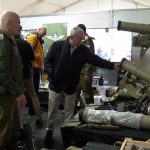An important milestone has been reached with the start of engine testing that will power NASA’s silent experimental X-59 supersonic aircraft.
These engine start-up tests, which began on October 30, allow the X-59 team to verify the joint operation of the aircraft’s systems powered by its own engine. In previous tests, the X-59 used external power sources. The engine start-up tests prepare the ground for the next step towards the first flight of the experimental aircraft.
The X-59 team is performing phased engine start tests. In this first phase, the engine was operated at a relatively low speed without ignition to check for leaks and ensure that all systems were communicating correctly. Next, the team filled the plane with fuel and began testing the engine at low power, with the aim of verifying that this and other aircraft systems function without anomalies or leaks while the engine is on.
When flying faster than the speed of sound, the X-59 will generate a much quieter boom than other aircraft in the same situation.
This plane is the centerpiece of NASA’s Quesst mission, aimed at collecting data on how people perceive these booms, providing information to regulators that could help eliminate existing bans on commercial supersonic flights over land.
The engine, a modified F-18 Super Hornet F414-GE-100, contains almost 10,000 kilograms of propulsive energy, which will allow the X-59 to reach the desired cruising speed of Mach 1.4 (almost 1,500 kilometers per hour) at an altitude of approximately almost 17,000 meters. The engine is located in a non-traditional location, at the top of the aircraft, to help make the X-59 quieter.
NASA’s silent X-59 experimental supersonic aircraft at the Lockheed Martin facility in Palmdale, California, starting its engine for the first time. (Photo: NASA / Carla Thomas)
The engine tests are part of a series of tests necessary to ensure flight safety and to achieve the success of the mission objectives. Due to the challenges of achieving this critical phase of testing, the first flight of the X-59 is now scheduled for 2025. The technical team will continue to advance critical ground testing and address any technical issues discovered with this unique aircraft. in its genre. The X-59 team will have a more specific first flight date once these tests are successfully completed.
The tests are being carried out at a Lockheed Martin company facility in Palmdale, California, United States. During subsequent phases, the team will test the aircraft at high power with rapid throttle changes, followed by a simulation of flight conditions. (Source: Nicolas Cholula / NASA)



![[Img #74662]](https://thelatestnews.world/wp-content/uploads/2024/12/Organisms-with-the-shortest-life-150x150.jpg)







![[Img #74336]](https://thelatestnews.world/wp-content/uploads/2024/11/Silent-supersonic-aircraft-X-59-starts-its-engine-for-the-first.jpg)
![[Img #74662]](https://thelatestnews.world/wp-content/uploads/2024/12/Organisms-with-the-shortest-life-300x200.jpg)


Add Comment